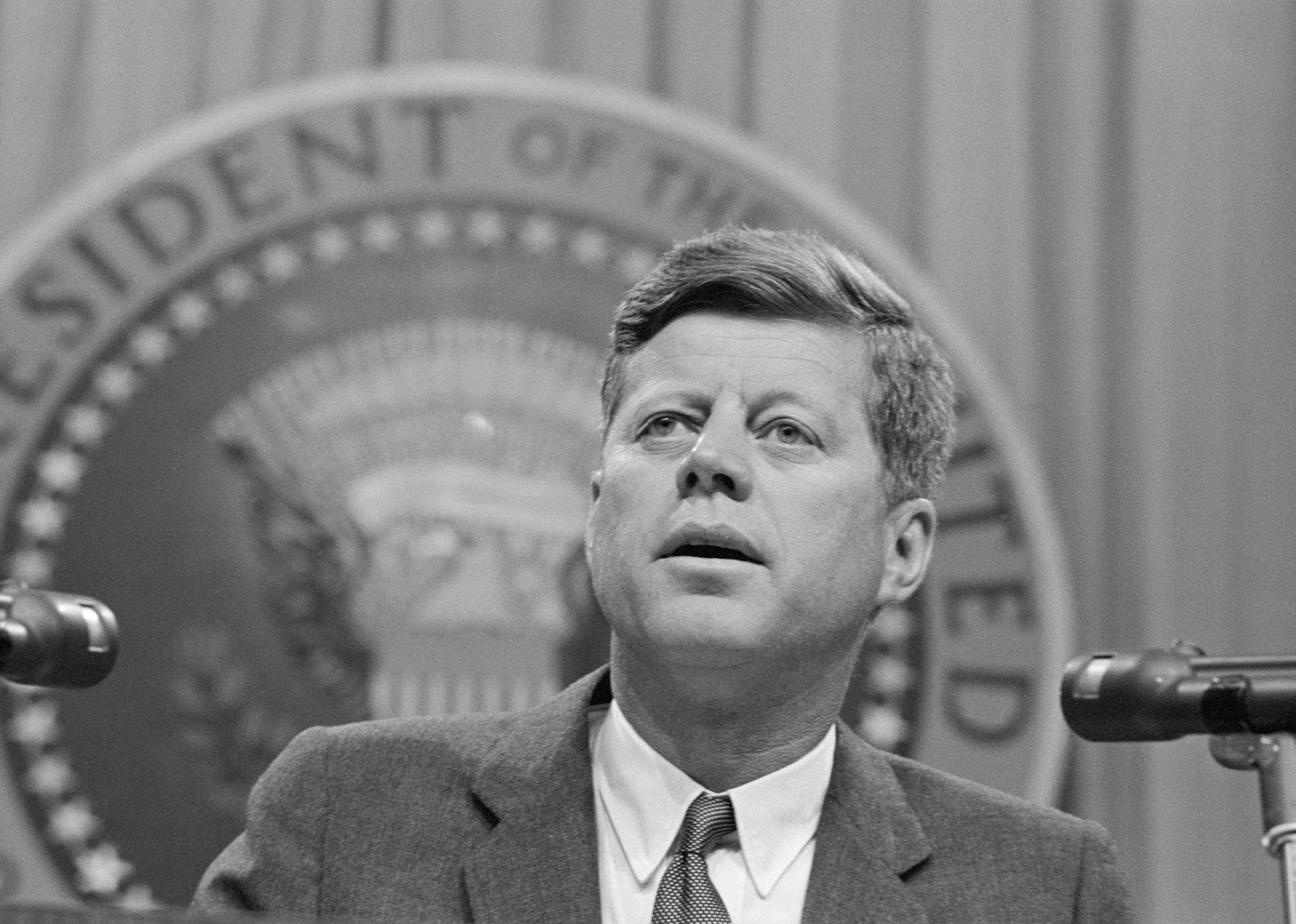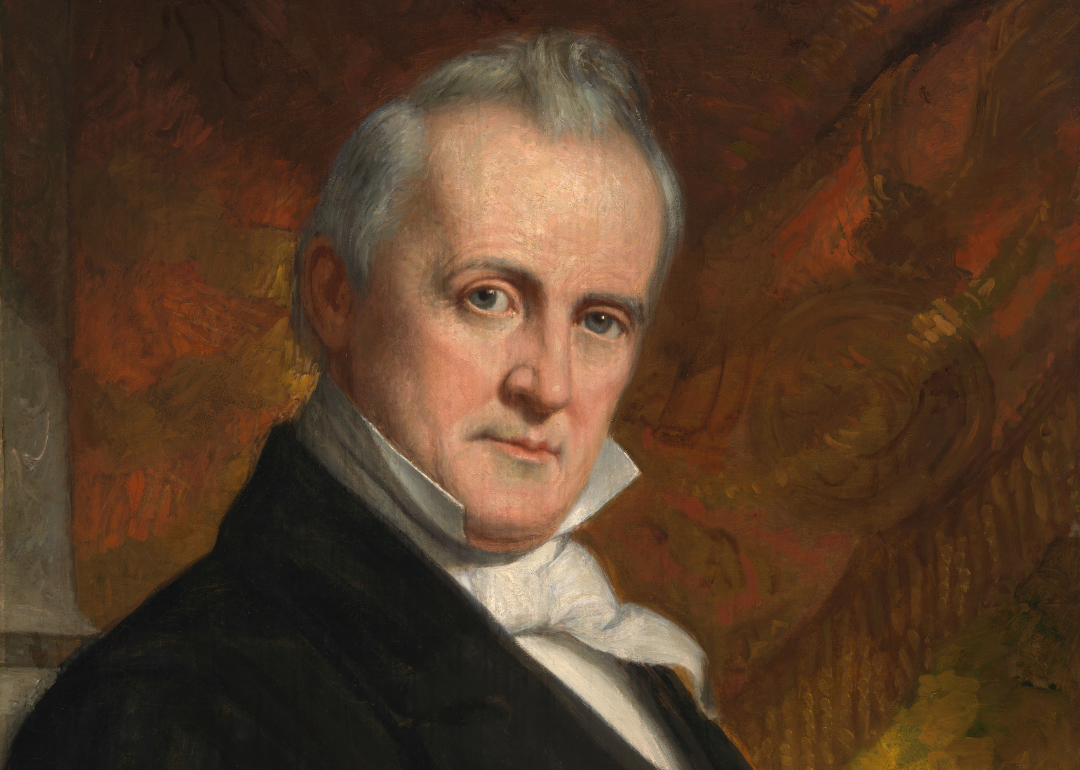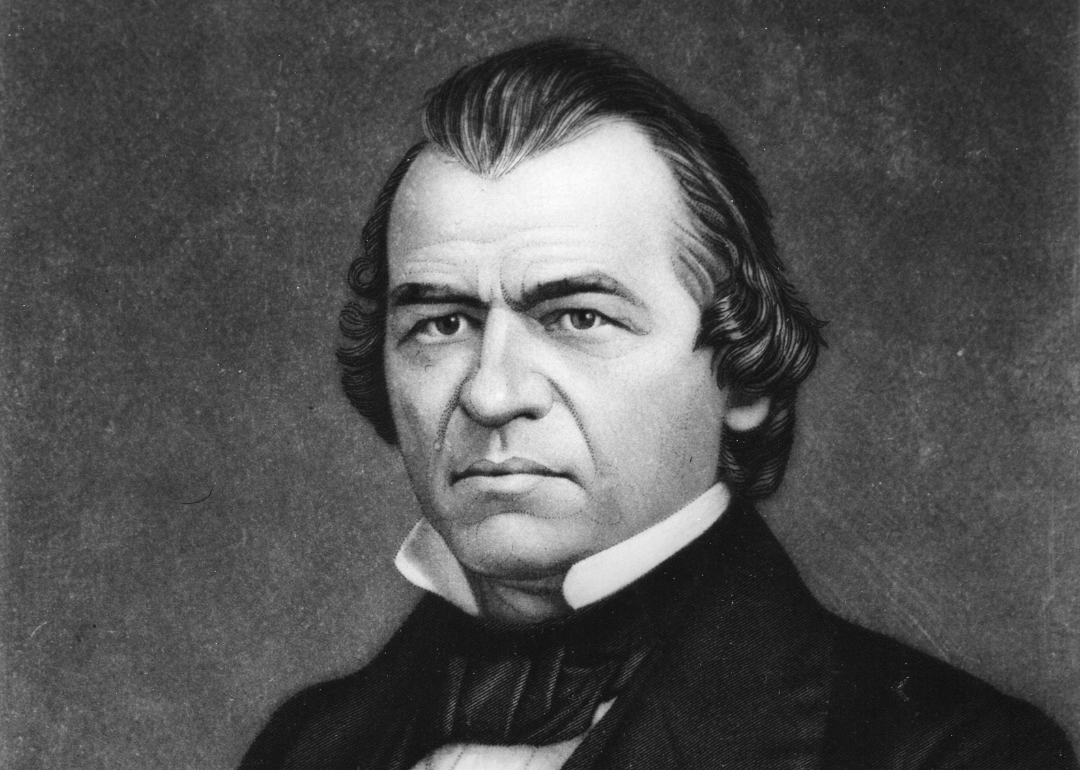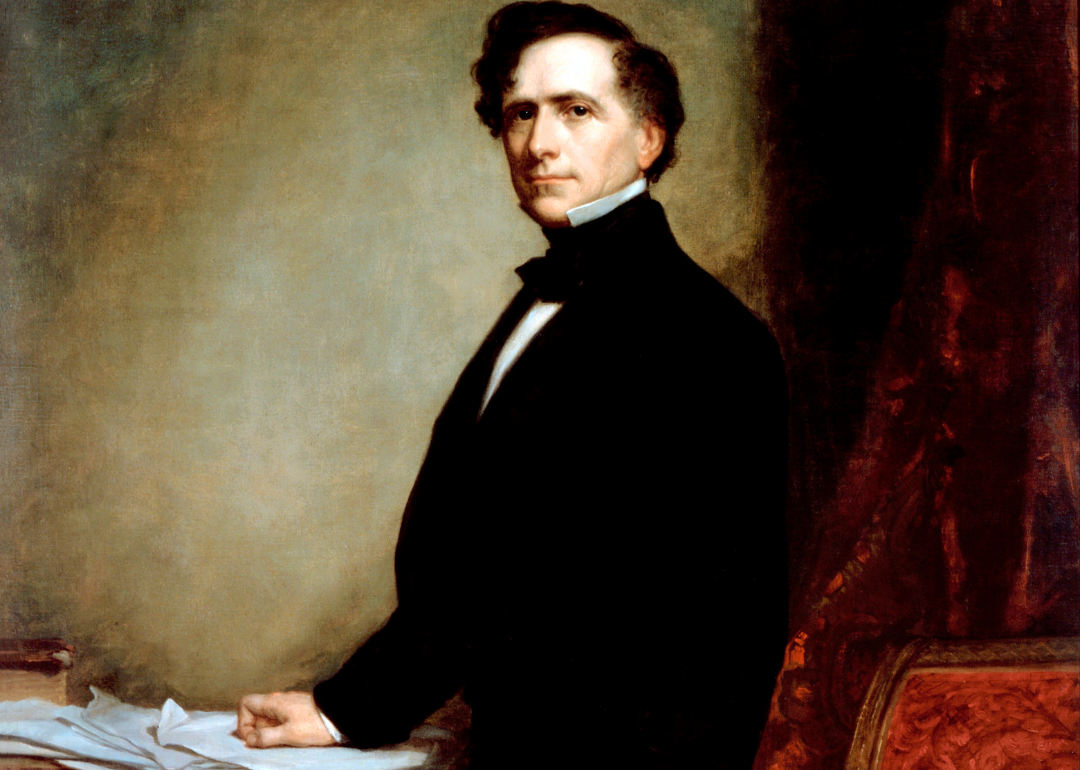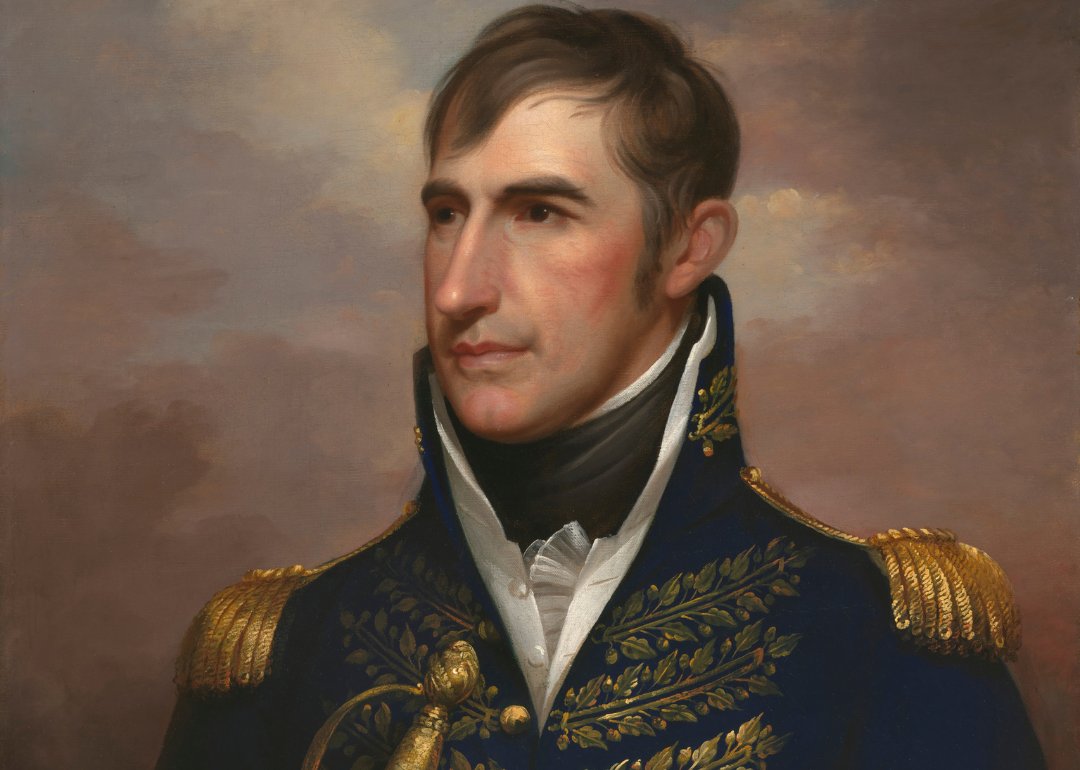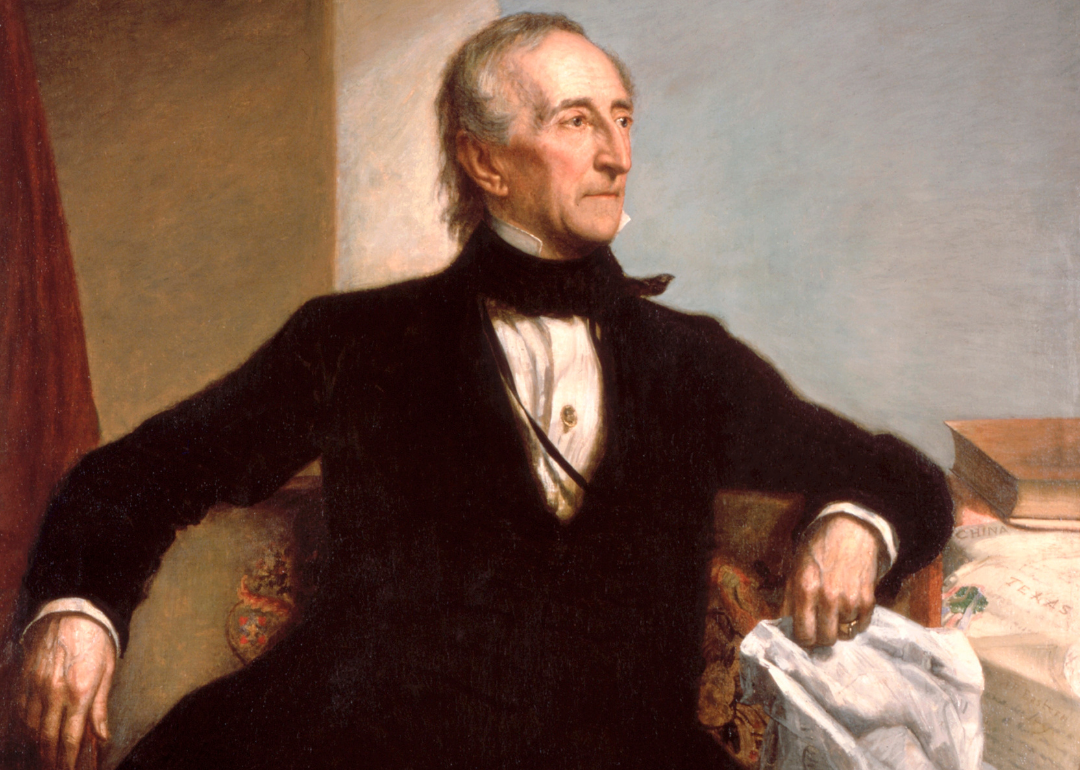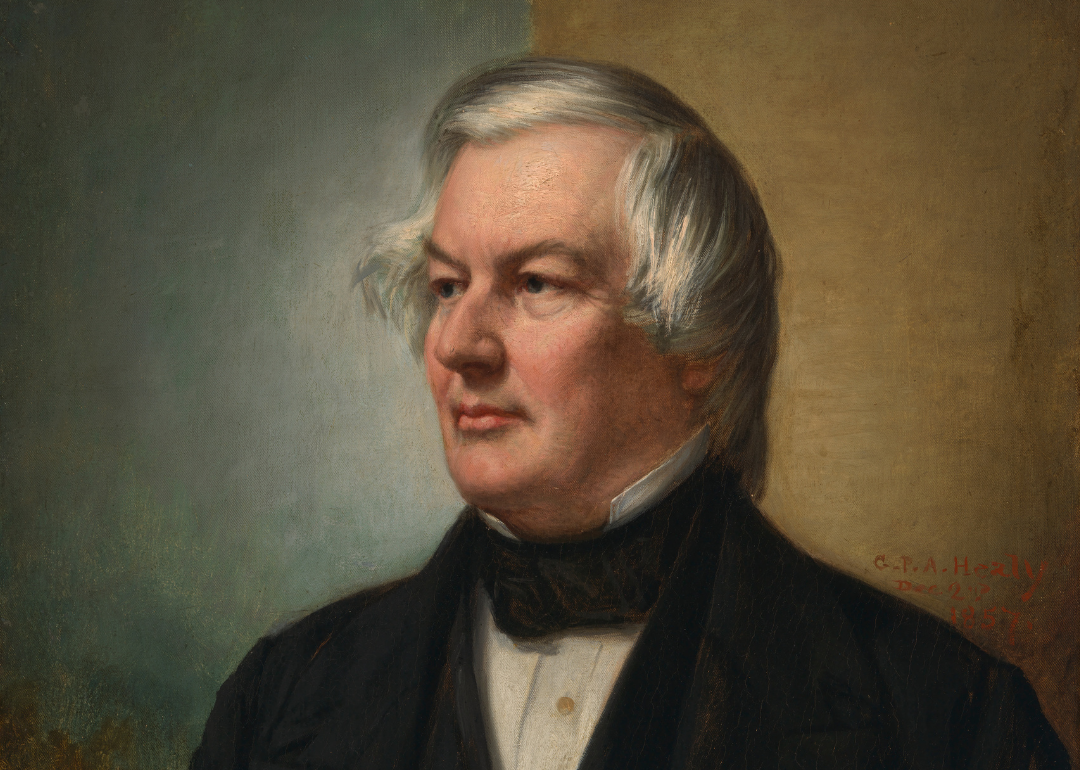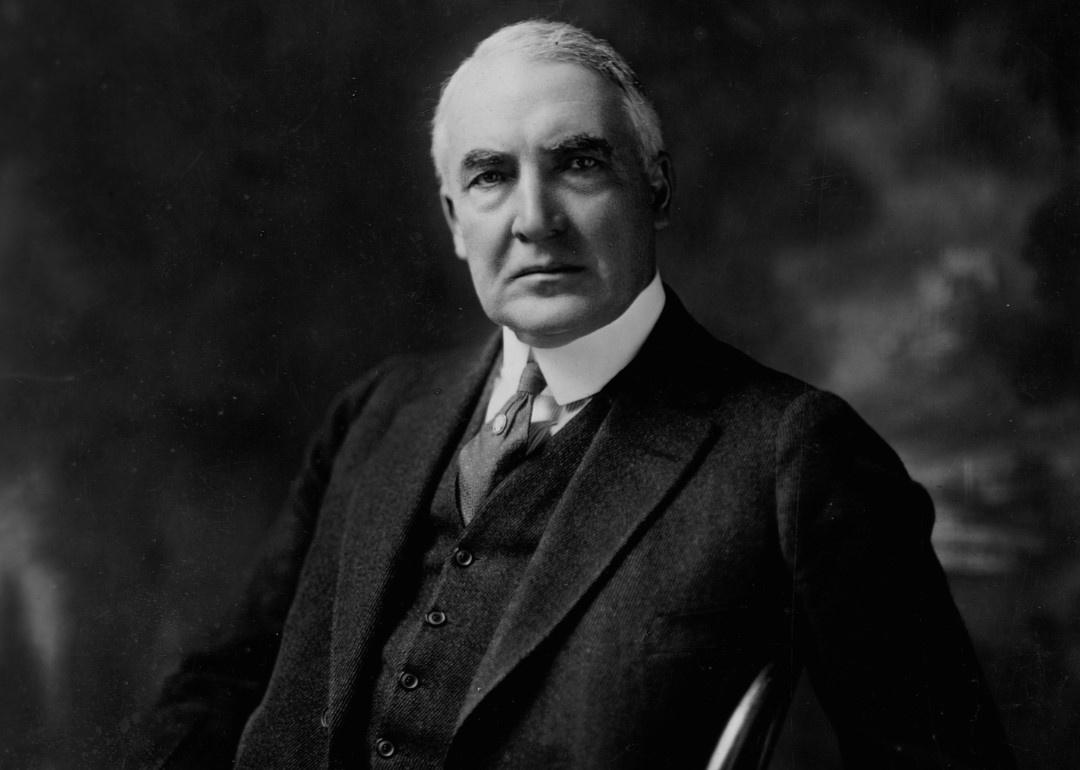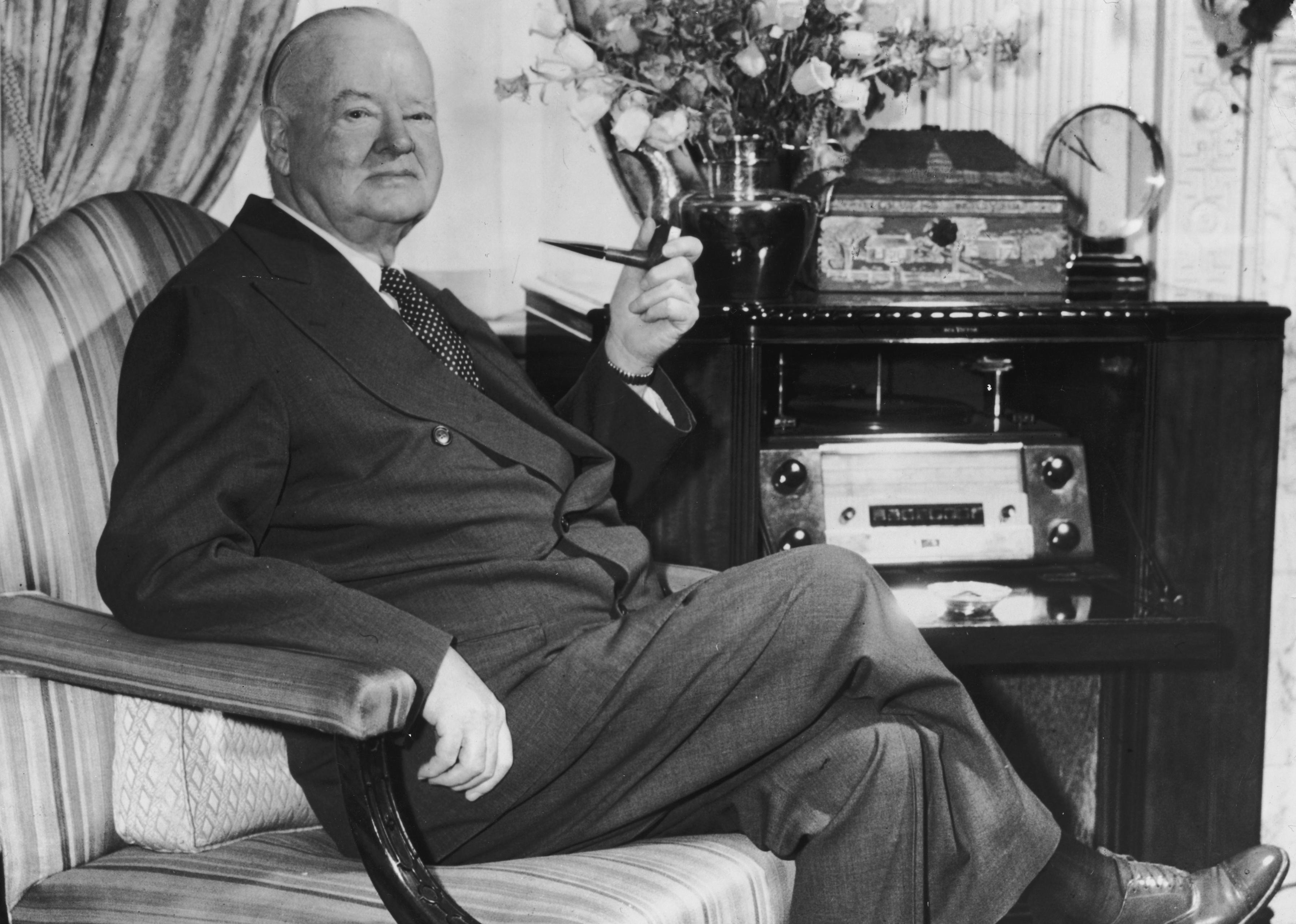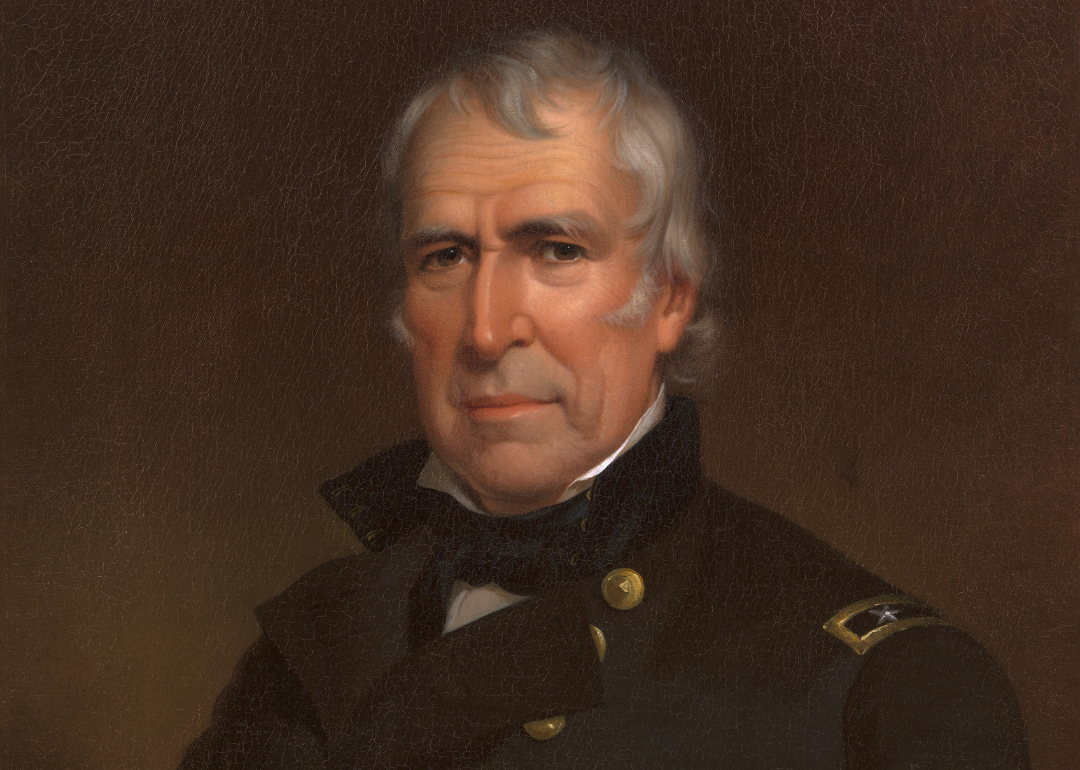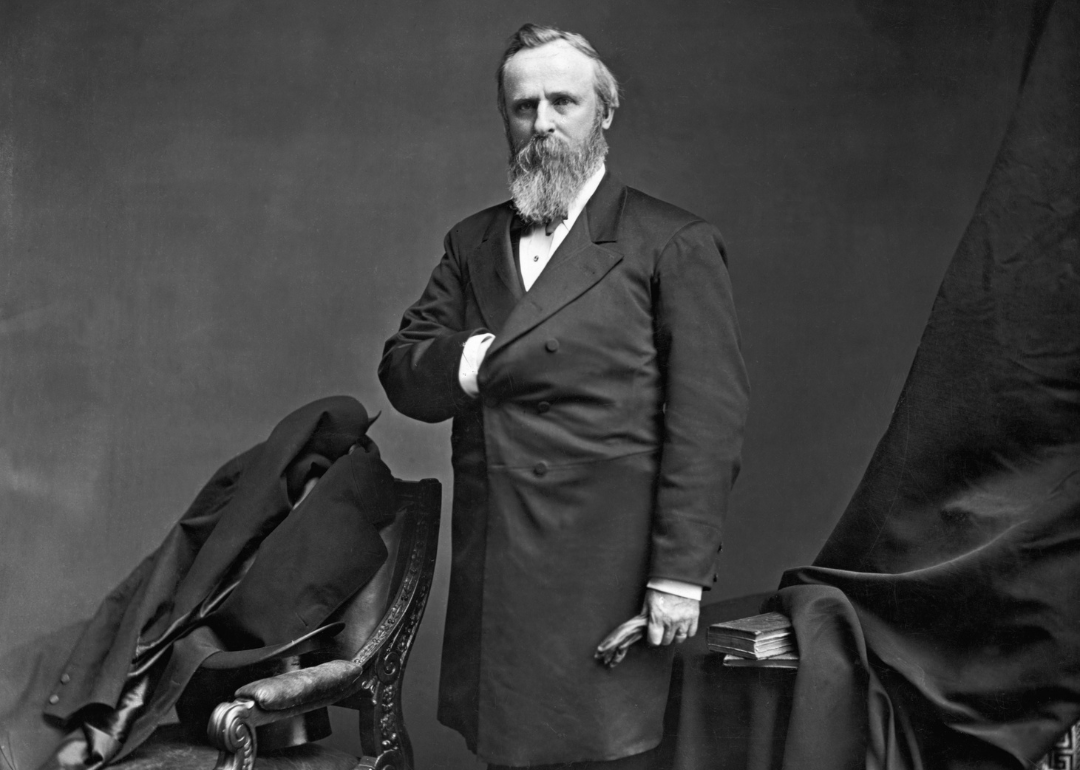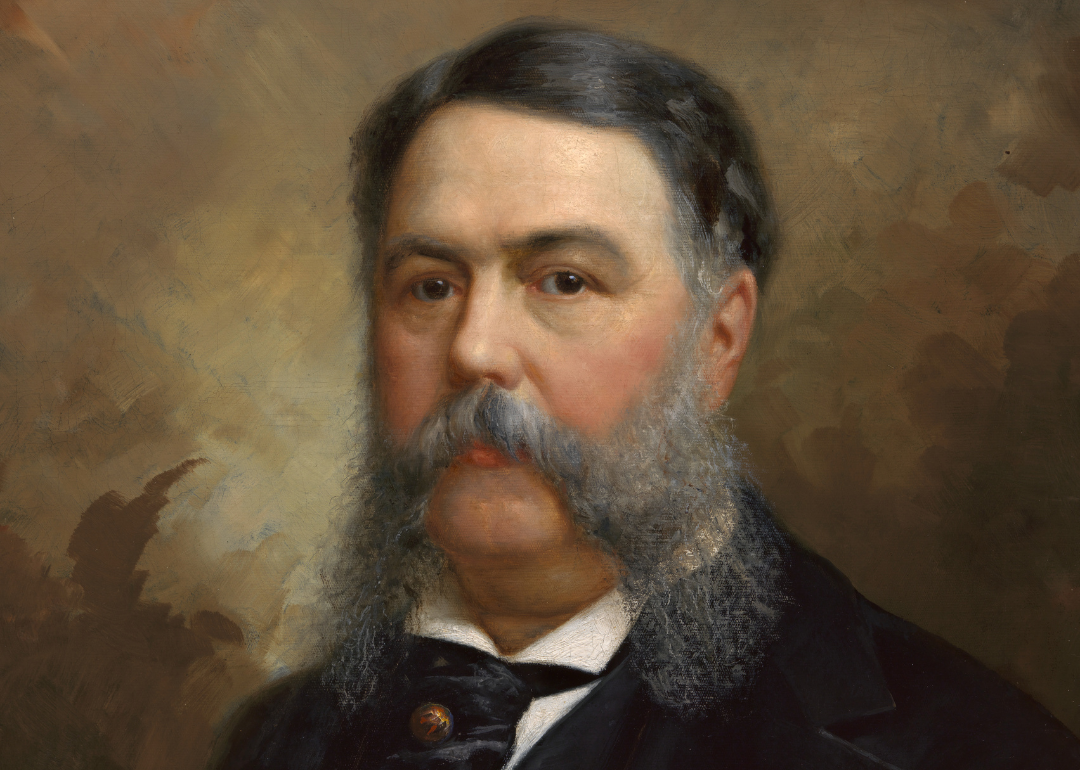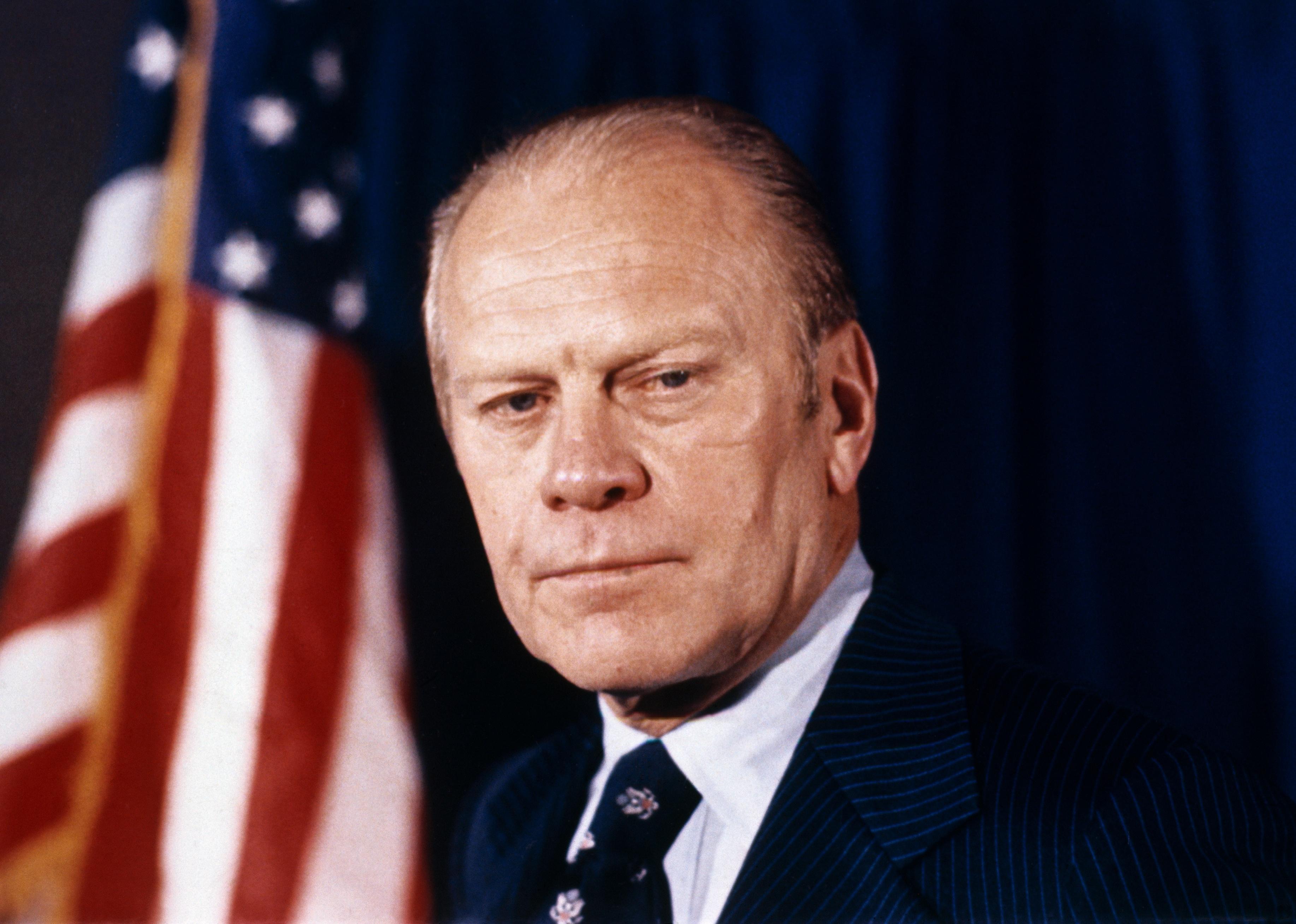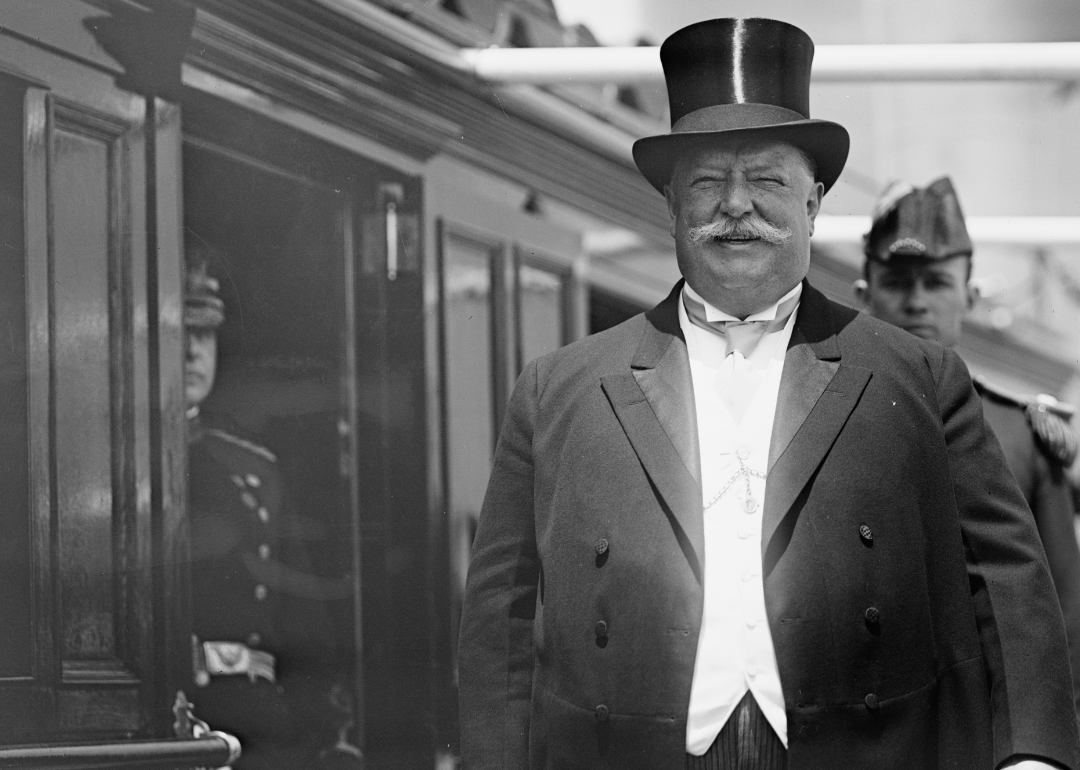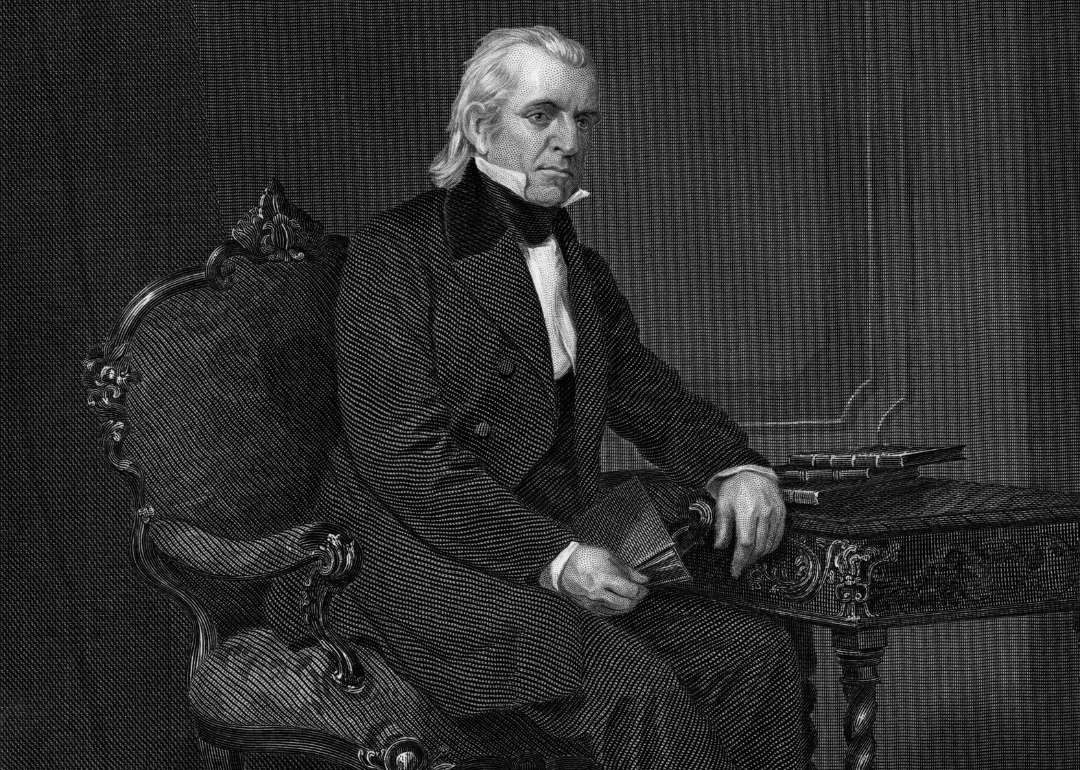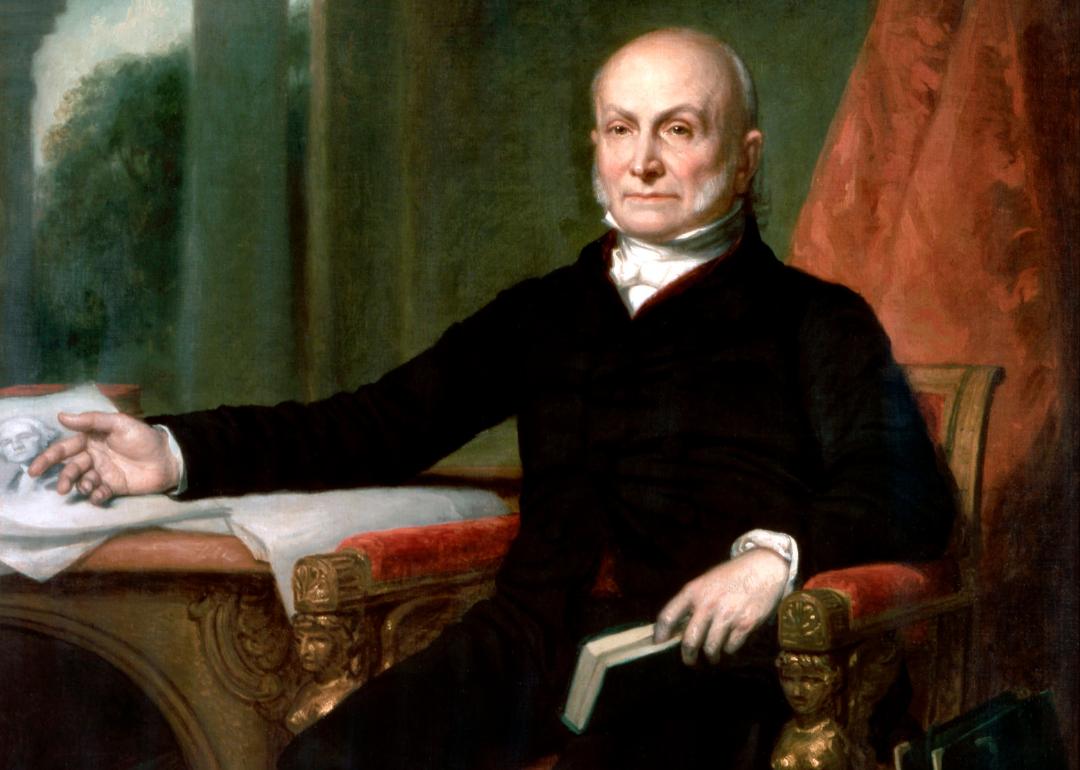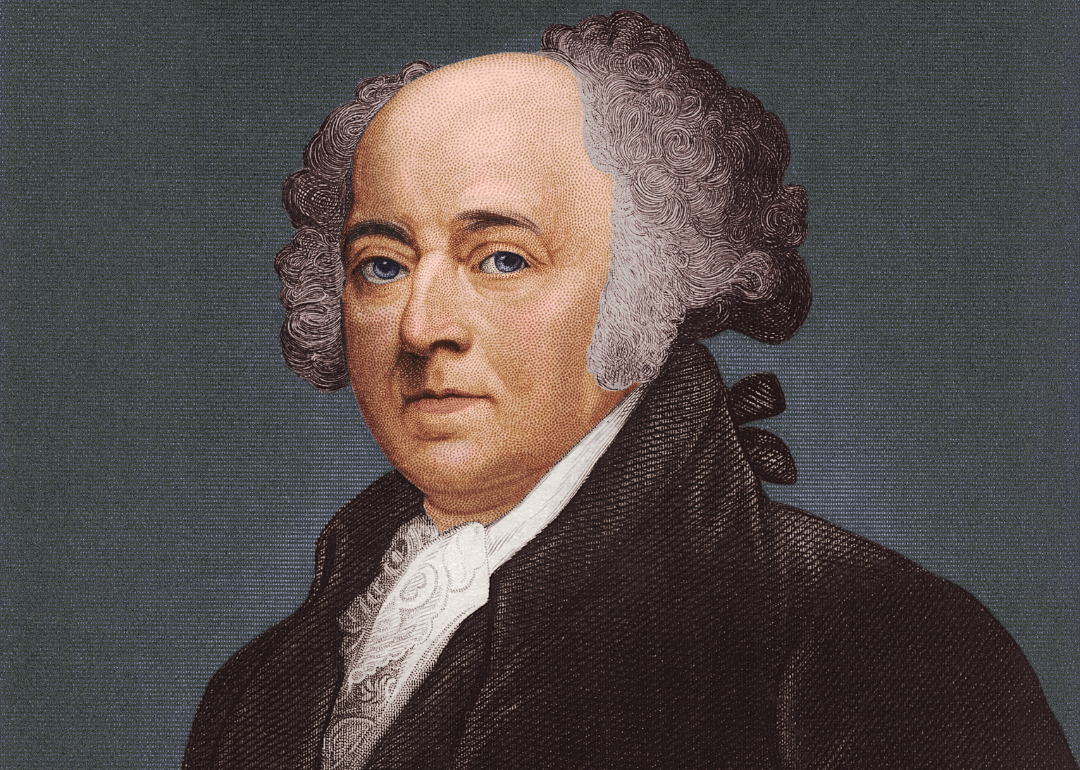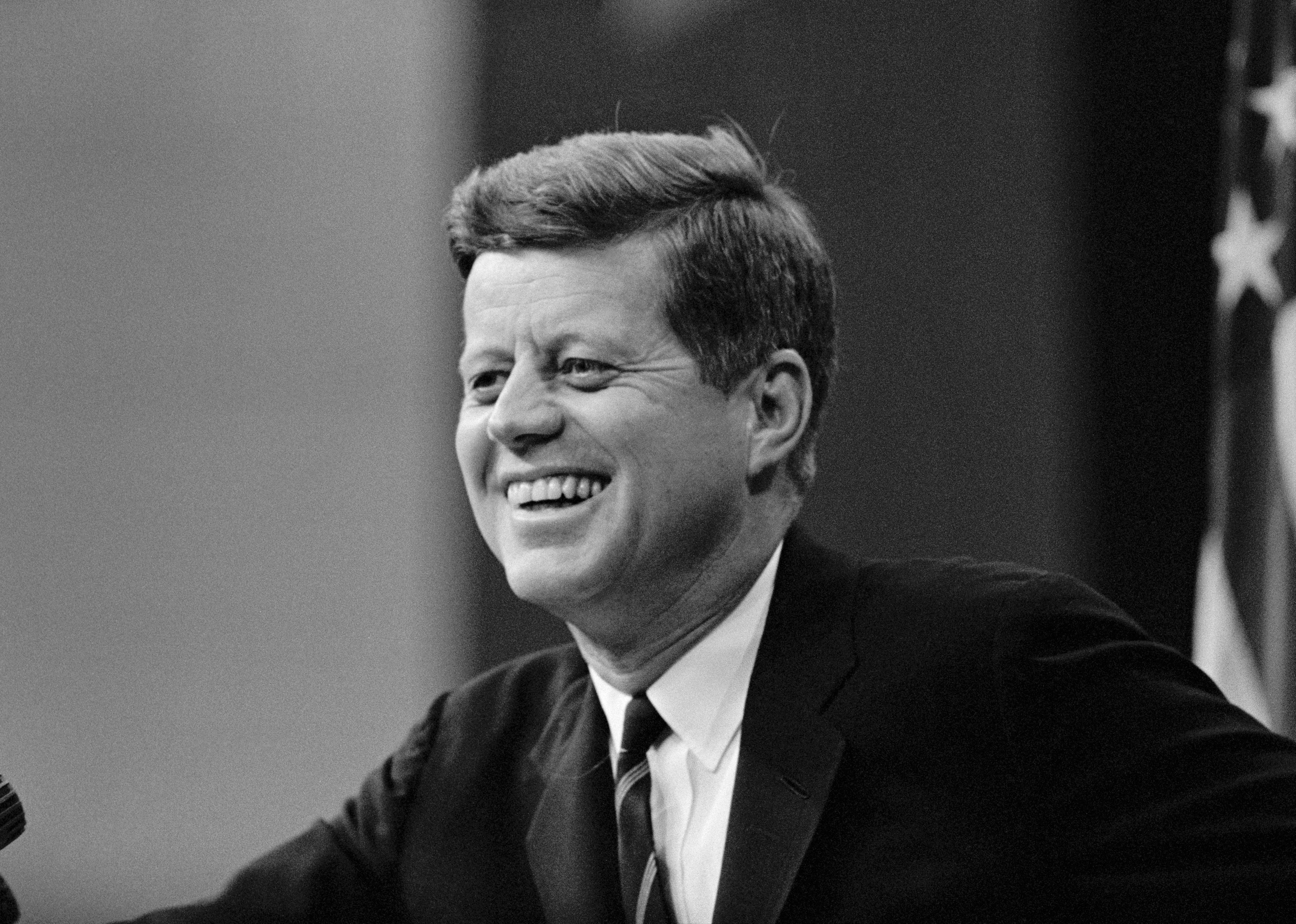US presidents who only served one term or less, ranked
Bettmann/Contributor // Getty Images
US presidents who only served one term or less, ranked
John F. Kennedy speaking in front of the presidential seal.
Research has found that the successes and failures of most presidents fade from public memory within 50 to 100 years after they leave the White House. This is especially true for the many bearded men of the 19th century, as some historians call them, who held the country’s highest office for one term or less.
The men consistently making the lists of history’s most forgettable presidents—Millard Fillmore, Warren G. Harding, and Martin Van Buren, to name a few—all served for a single term, or less if tragedy befell them. It should come as no surprise that many of these same men are ranked among the worst presidents of all time, according to historians.
Experts generally agree that evaluating the effectiveness of one-term presidents is difficult. The central question is whether their legacies are shaped primarily by their actions in office, or by external conditions largely beyond their control, like economic downturns. Presidents inheriting faltering economies, war, or civil unrest upon entering the White House, for example, may have less flexibility to enact their own political agendas or follow through on campaign promises.
Some former presidents vowed only to serve one term when they took office; others sought reelection despite discontent among their parties and the American public and failed—often spectacularly. One-term presidents were more common in the mid- to late-19th century than they are in modern history. Donald Trump was the first president in nearly 30 years to lose a reelection bid.
Stacker analyzed how single-term U.S. presidents compare in the eyes of professional observers of the presidency, using C-SPAN’s June 2021 ranking of 44 U.S. presidents. The survey was devised by academic advisers, creating a numeric scale to rate presidents as effective or ineffective in 10 categories: public persuasion, crisis leadership, economic management, moral authority, international relations, administrative skills, congressional relations, agenda setting, the pursuit of equal justice for all, and overall performance within the context of the times.
In 2021, 142 historians, professors, and other professional observers participated in the survey. “One-term” presidents include those who did not win reelection and those who may not have finished their first terms. Single-term presidents are ranked here by their position among all presidents’ C-SPAN scores, which are out of 1,000. Category scores, also listed, are out of 100.
You may also like: Women politicians who broke barriers
![]()
Heritage Art/Heritage Images // Getty Images
#23. James Buchanan
A painting of James Buchanan.
– 15th president (March 4, 1857-March 4, 1861)
– Political party: Democratic
– Overall C-SPAN score: 227
— Political persuasion: 21.8 (#43 among all presidents)
— Crisis leadership: 16.1 (#44)
— Economic management: 27.8 (#43)
— Moral authority: 19.1 (#43)
— International relations: 30.5 (#44)
— Administrative skills: 30.5 (#42)
— Congressional relations: 25.6 (#43)
— Vision/ability to set an agenda: 19.1 (#44)
— Pursued equal justice for all: 17.9 (#44)
— Performance within context of the times: 19.1 (#44)
James Buchanan vowed to only serve one term from the first day he took office, which is likely a good thing, in retrospect, since experts rank him as the worst president of all time. Buchanan inherited a territorial mess left behind by Franklin Pierce as a result of the Kansas-Nebraska Act. His legacy is defined by his failures, the most significant being his indifference toward slavery and his sympathies towards the Confederacy. In his inaugural speech, Buchanan referred to slavery as “happily, a matter of but little practical importance.”
PhotoQuest // Getty Images
#22. Andrew Johnson
A portrait of Andrew Johnson in a suit.
– 17th president (April 15, 1865-March 4, 1869)
– Political party: National Union
– Overall C-SPAN score: 230
— Political persuasion: 21.7 (#44 among all presidents)
— Crisis leadership: 19.8 (#43)
— Economic management: 30.8 (#42)
— Moral authority: 20.3 (#42)
— International relations: 33.9 (#42)
— Administrative skills: 25.9 (#43)
— Congressional relations: 15.2 (#44)
— Vision/ability to set an agenda: 21.7 (#43)
— Pursued equal justice for all: 19.8 (#43)
— Performance within context of the times: 21.1 (#43)
Andrew Johnson served as vice president to Abraham Lincoln and took office after Lincoln’s assassination in 1865. Johnson is often criticized for his racist ideologies and inability to compromise with political opponents. He was a staunch opponent of the 14th Amendment, the Freedmen’s Bureau Bill, and the Civil Rights Act of 1866, all of which expanded civil rights. Consequently, Reconstruction failed in the South and led to further national divisions during his term in office. Johnson made history as the first U.S. president to be impeached in the House of Representatives.
GraphicaArtis // Getty Images
#20. Franklin Pierce (tie)
A painting of Franklin Pierce.
– 14th president (March 4, 1853-March 4, 1857)
– Political party: Democratic
– Overall C-SPAN score: 312
— Political persuasion: 30.1 (#42 among all presidents)
— Crisis leadership: 25.0 (#42)
— Economic management: 37.3 (#38)
— Moral authority: 29.2 (#39)
— International relations: 36.2 (#40)
— Administrative skills: 38.2 (#39)
— Congressional relations: 37.0 (#39)
— Vision/ability to set an agenda: 27.3 (#42)
— Pursued equal justice for all: 23.0 (#42)
— Performance within context of the times: 28.5 (#41)
The biggest mark on the face of Franklin Pierce’s presidency was the Kansas-Nebraska Act of 1854. The act repealed the prohibition against slavery in northern territories and allowed voters in territories like Kansas, formerly a free state, to decide if they wanted slavery. Violence erupted into what became known as “Bleeding Kansas”—a series of conflicts between proslavery and antislavery advocates. Pierce lost the support of his Democratic Party and was not reelected for a second term.
Brandon Bell // Getty Images
#20. Donald Trump (tie)
Donald Trump in a blue suit and red tie.
– 45th president (Jan. 20, 2017-Jan. 20, 2021)
– Political party: Republican
– Overall C-SPAN score: 312
— Political persuasion: 43.9 (#32 among all presidents)
— Crisis leadership: 26.5 (#41)
— Economic management: 42.7 (#34)
— Moral authority: 18.7 (#44)
— International relations: 33.3 (#43)
— Administrative skills: 22.8 (#44)
— Congressional relations: 28.6 (#42)
— Vision/ability to set an agenda: 39.6 (#36)
— Pursued equal justice for all: 27.6 (#40)
— Performance within context of the times: 28.3 (#42)
Donald Trump and his supporters have repeatedly claimed that the only reason he is not currently serving a second term is that the election was stolen from him—a claim that has been evaluated and disproven. Trump was often criticized for largely serving as president only of his political base.
When he ran for reelection, he took the same approach—sowing division and reiterating disproven conspiracy theories without ever outlining a clear vision for his second term. Trump lost to Joe Biden in the 2020 election. Instead of a peaceful transition of power, insurrectionists goaded by Trump stormed the U.S. Capitol on the day the election results were certified.
Heritage Art/Heritage Images // Getty Images
#18. William Henry Harrison (tie)
A painting of William Henry Harrison in a military uniform.
– 9th president (March 4, 1841-April 4, 1841)
– Political party: Whig
– Overall C-SPAN score: 354
— Political persuasion: 39.2 (#38 among all presidents)
— Crisis leadership: 31.9 (#39)
— Economic management: 32.7 (#41)
— Moral authority: 43.8 (#35)
— International relations: 34.0 (#41)
— Administrative skills: 34.6 (#40)
— Congressional relations: 36.2 (#40)
— Vision/ability to set an agenda: 37.6 (#37)
— Pursued equal justice for all: 30.8 (#36)
— Performance within context of the times: 32.9 (#40)
William Henry Harrison holds the record for the shortest presidential tenure, serving just 32 days before becoming the first president to die in office. Harrison succumbed to a cold that turned into pneumonia—a leading cause of death during the 19th century. Because of this, Harrison’s list of presidential accomplishments is short, and his tenure was mostly defined by organizational inefficiencies. Before becoming president, Harrison is probably best remembered for leading the Battle of Tippecanoe.
You may also like: Youngest and oldest presidents in US history
GraphicaArtis // Getty Images
#18. John Tyler (tie)
A painting of John Tyler in a black suit.
– 10th president (April 4, 1841-March 4, 1845)
– Political party: Independent
– Overall C-SPAN score: 354
— Political persuasion: 34.9 (#40 among all presidents)
— Crisis leadership: 38.6 (#36)
— Economic management: 36.2 (#40)
— Moral authority: 33.8 (#37)
— International relations: 45.2 (#35)
— Administrative skills: 39.1 (#38)
— Congressional relations: 30.5 (#41)
— Vision/ability to set an agenda: 35.9 (#40)
— Pursued equal justice for all: 24.0 (#41)
— Performance within context of the times: 35.8 (#38)
John Tyler rose from vice president to president following William Henry Harrison’s death. His greatest accomplishment was establishing that vice presidents who become president through succession have no less authority than their predecessors. Tyler had different political views and ideologies than the cabinet curated by Harrison, and as a result, he had no allies in Congress. This loathing made Tyler an ineffective leader. Tyler made a bid for a second term with a new party as the Democratic-Republican candidate but lost to James K. Polk.
Heritage Art/Heritage Images // Getty Images
#17. Millard Fillmore
A painting of Millard Fillmore.
– 13th president (July 9, 1850-March 4, 1853)
– Political party: Whig
– Overall C-SPAN score: 378
— Political persuasion: 33.5 (#41 among all presidents)
— Crisis leadership: 37.9 (#37)
— Economic management: 40.3 (#36)
— Moral authority: 34.5 (#36)
— International relations: 42.6 (#37)
— Administrative skills: 42.9 (#37)
— Congressional relations: 43.9 (#35)
— Vision/ability to set an agenda: 34.5 (#41)
— Pursued equal justice for all: 30.2 (#38)
— Performance within context of the times: 37.3 (#36)
Millard Fillmore took office following the death of Zachary Taylor one year into his term. Fillmore is best remembered for ushering in the Compromise of 1850—a series of bills addressing the issue of slavery, one of which was the Fugitive Slave Act. While regional divisions between the North and South were prevalent at the time, Fillmore’s policies angered both. As a result, he lost his bid for a second term in 1856.
Library of Congress/Corbis/VCG // Getty Images
#16. Warren G. Harding
A portrait of Warren G. Harding in a dark suit.
– 29th president (March 4, 1921-Aug. 2, 1923)
– Political party: Republican
– Overall C-SPAN score: 388
— Political persuasion: 43.4 (#33 among all presidents)
— Crisis leadership: 32.8 (#38)
— Economic management: 44.7 (#32)
— Moral authority: 26.9 (#40)
— International relations: 46.3 (#34)
— Administrative skills: 33.4 (#41)
— Congressional relations: 45.4 (#33)
— Vision/ability to set an agenda: 37.3 (#38)
— Pursued equal justice for all: 40.5 (#30)
— Performance within context of the times: 37.1 (#37)
Warren G. Harding died of a heart attack two years into his term. Harding scored lowest in administrative skills primarily because of rampant corruption within his administration, which marred his abbreviated time in office. The most notable example is the Teapot Dome Scandal, in which the secretary of the interior leased oil-rich lands in Wyoming to companies in exchange for personal loans.
Hulton Archive // Getty Images
#15. Herbert Hoover
Herbert Hoover in a chair with legs crossed holding a pipe.
– 31st president (March 4, 1929-March 4, 1933)
– Political party: Republican
– Overall C-SPAN score: 396
— Political persuasion: 35.0 (#39 among all presidents)
— Crisis leadership: 26.6 (#40)
— Economic management: 26.2 (#44)
— Moral authority: 47.1 (#30)
— International relations: 46.7 (#32)
— Administrative skills: 60.0 (#20)
— Congressional relations: 43.9 (#36)
— Vision/ability to set an agenda: 37.0 (#39)
— Pursued equal justice for all: 39.7 (#32)
— Performance within context of the times: 33.7 (#39)
Herbert Hoover served his only term during the onset of the Great Depression. Though Hoover cannot be blamed entirely for the economic crash of 1929, experts criticize him for prolonging its severity by refusing to leverage federal spending to stimulate the economy or authorize large-scale relief programs.
Hoover disapproved of government handouts and believed help should come from local sources, like businesses, on a voluntary basis. Unsurprisingly, experts rank him as among the worst presidents when it comes to economic management. Hoover sought reelection in 1932 but lost by a landslide to Franklin D. Roosevelt.
Heritage Art/Heritage Images // Getty Images
#14. Zachary Taylor
A painting of Zachary Taylor in a miltary jacket.
– 12th president (March 4, 1849-July 9, 1850)
– Political party: Whig
– Overall C-SPAN score: 449
— Political persuasion: 44.1 (#31 among all presidents)
— Crisis leadership: 47.4 (#29)
— Economic management: 46.3 (#30)
— Moral authority: 48.0 (#29)
— International relations: 46.8 (#31)
— Administrative skills: 47.2 (#35)
— Congressional relations: 43.8 (#37)
— Vision/ability to set an agenda: 44.1 (#32)
— Pursued equal justice for all: 36.2 (#34)
— Performance within context of the times: 45.0 (#34)
Before becoming president, Zachary Taylor was regarded as a war hero. Taylor was born into a family of wealthy Southern plantation owners and enslavers and claimed ownership of 100 enslaved people himself. His brief time in office focused on whether the national government should permit the spread of slavery to the territory comprising the present-day states of California, New Mexico, and Utah.
Despite his personal practices, Taylor did not politically defend or push for slavery, nor did he push to prevent it. Instead, he pushed for the states to decide for themselves. Taylor died from what some experts believe to be gastroenteritis 16 months into his term, leaving Vice President Millard Fillmore in charge.
You may also like: Top issues being lobbied today—and the companies that support them
PhotoQuest // Getty Images
#13. Martin Van Buren
Martin Van Buren in a dark suit jacket.
– 8th president (March 4, 1837-March 4, 1841)
– Political party: Democratic
– Overall C-SPAN score: 455
— Political persuasion: 45.5 (#29 among all presidents)
— Crisis leadership: 41.1 (#34)
— Economic management: 37.2 (#39)
— Moral authority: 45.4 (#34)
— International relations: 52.2 (#26)
— Administrative skills: 54.6 (#25)
— Congressional relations: 49.4 (#28)
— Vision/ability to set an agenda: 45.6 (#30)
— Pursued equal justice for all: 38.3 (#33)
— Performance within context of the times: 45.3 (#33)
Just a few months after taking office, Martin Van Buren was forced to deal with the Panic of 1837—the worst economic depression ever to engulf the country up until that point. Experts agree that Van Buren was ineffective at stemming the financial collapse, which explains why he received one of the lowest economic management ratings of any president. Van Buren won the Democratic nomination for a second term but lost to William Henry Harrison, the Whig party nominee. Van Buren later sought reelection in 1848 as part of the newly formed Free Soil Party but was unsuccessful.
Bettmann/Contributor // Getty Images
#12. Rutherford B. Hayes
Rutherford B. Hayes posing for a portrait in a long dark suit jacket.
– 19th president (March 4, 1877-March 4, 1881)
– Political party: Republican
– Overall C-SPAN score: 456
— Political persuasion: 44.2 (#30 among all presidents)
— Crisis leadership: 43.0 (#33)
— Economic management: 47.2 (#29)
— Moral authority: 45.5 (#33)
— International relations: 48.0 (#30)
— Administrative skills: 50.9 (#31)
— Congressional relations: 48.5 (#31)
— Vision/ability to set an agenda: 43.2 (#33)
— Pursued equal justice for all: 39.9 (#31)
— Performance within context of the times: 45.9 (#32)
Rutherford B. Hayes’ path to the presidency was controversial and unusual. As a result, he vowed to serve just one term—a move that preserved the integrity of the office. During his term, Hayes oversaw the end of Reconstruction and the end of the federal government’s responsibility to protect the rights of formerly enslaved people.
Library of Congress/Corbis/VCG // Getty Images
#11. Benjamin Harrison
Benjamin Harrison sitting at a desk in a dark suit.
– 23rd president (March 4, 1889-March 4, 1893)
– Political party: Republican
– Overall C-SPAN score: 462
— Political persuasion: 41.9 (#36 among all presidents)
— Crisis leadership: 43.4 (#32)
— Economic management: 45.0 (#31)
— Moral authority: 48.6 (#27)
— International relations: 49.4 (#29)
— Administrative skills: 49.7 (#32)
— Congressional relations: 48.8 (#30)
— Vision/ability to set an agenda: 43.1 (#34)
— Pursued equal justice for all: 45.5 (#23)
— Performance within context of the times: 46.7 (#31)
Benjamin Harrison was the grandson of President William Henry Harrison. His economic policies are believed to have contributed to the Panic of 1893—one of the worst economic downturns in American history. Historians point to Harrison’s lack of awareness and disconnect from the reality of American life as the primary cause of his ineffectiveness domestically. Grover Cleveland defeated Harrison in his 1892 bid for reelection due to the nation’s growing disapproval of high tariffs and federal spending.
Heritage Art/Heritage Images // Getty Images
#10. Chester A. Arthur
A painting of Chester A. Arthur in a suit.
– 21st president (Sept. 19, 1881-March 4, 1885)
– Political party: Republican
– Overall C-SPAN score: 472
— Political persuasion: 43.1 (#34 among all presidents)
— Crisis leadership: 45.1 (#31)
— Economic management: 47.9 (#27)
— Moral authority: 47.0 (#31)
— International relations: 46.6 (#33)
— Administrative skills: 54.9 (#24)
— Congressional relations: 50.7 (#27)
— Vision/ability to set an agenda: 44.6 (#31)
— Pursued equal justice for all: 43.3 (#27)
— Performance within context of the times: 48.5 (#28)
Chester Arthur became president through succession after James Garfield died from blood poisoning following an assassination attempt. Though his presidency was largely unremarkable, which might suggest an absence of a detrimental legacy, Arthur gets low ratings across the board. Arthur’s administration enacted the first immigration law, which excluded Chinese people, in addition to “paupers, criminals, and lunatics,” leading to his low rank in the context of the pursuit of equal justice for all.
Bettmann/Contributor // Getty Images
#9. Gerald Ford
Gerald Ford in a blue pinstripe suit in front of an American flag.
– 38th president (Aug. 9, 1974-Jan. 20, 1977)
– Political party: Republican
– Overall C-SPAN score: 498
— Political persuasion: 41.6 (#37 among all presidents)
— Crisis leadership: 50.1 (#25)
— Economic management: 42.9 (#33)
— Moral authority: 59.5 (#20)
— International relations: 52.8 (#25)
— Administrative skills: 52.4 (#29)
— Congressional relations: 54.6 (#19)
— Vision/ability to set an agenda: 40.8 (#35)
— Pursued equal justice for all: 51.3 (#17)
— Performance within context of the times: 51.8 (#26)
Ford became president in 1974 after Richard Nixon resigned in the aftermath of the Watergate scandal. He inherited a slew of problems, including a failing economy, the collapse of South Vietnam, and public suspicion of political leaders in light of Watergate. In one of his first tasks as president, which would prove to be one of his biggest missteps, Ford pardoned Nixon—a move that damaged his political and public reputation. Ford was accused of doing little to alleviate the financial suffering of Americans. Ford sought reelection in 1976 but lost to Democratic candidate Jimmy Carter.
You may also like: History of the NRA
Heritage Art/Heritage Images // Getty Images
#7. James A. Garfield (tie)
A painting of James A. Garfield in a dark suit and bowtie.
– 20th president (March 4, 1881-Sept. 19, 1881)
– Political party: Republican
– Overall C-SPAN score: 506
— Political persuasion: 51.0 (#24 among all presidents)
— Crisis leadership: 46.4 (#30)
— Economic management: 49.2 (#26)
— Moral authority: 58.6 (#23)
— International relations: 44.9 (#36)
— Administrative skills: 53.2 (#28)
— Congressional relations: 51.1 (#26)
— Vision/ability to set an agenda: 47.8 (#29)
— Pursued equal justice for all: 51.9 (#16)
— Performance within context of the times: 51.5 (#27)
James Garfield was in office for just a few months before he was shot in an assassination attempt. He died less than three months later due to related complications. His short tenure did not allow for major accomplishments or failures.
Bettmann/Contributor // Getty Images
#7. Jimmy Carter (tie)
Jimmy Carter smiling at a podium in front of an American flag.
– 39th president (Jan. 20, 1977-Jan. 20, 1981)
– Political party: Democratic
– Overall C-SPAN score: 506
— Political persuasion: 43.0 (#35 among all presidents)
— Crisis leadership: 39.5 (#35)
— Economic management: 37.8 (#37)
— Moral authority: 71.7 (#7)
— International relations: 50.0 (#28)
— Administrative skills: 49.2 (#34)
— Congressional relations: 44.9 (#34)
— Vision/ability to set an agenda: 50.5 (#24)
— Pursued equal justice for all: 72.0 (#5)
— Performance within context of the times: 47.8 (#30)
Jimmy Carter faced several major challenges during his term, including lingering mistrust of political leaders from the Watergate crisis, an energy crisis, Soviet aggression, and the Iranian hostage crisis, the latter of which ultimately marred Carter’s reelection campaign. Carter lost in a landslide to Ronald Reagan. Carter’s legacy has improved over time, however, and he even won a Nobel Peace Prize in 2002.
Heritage Art/Heritage Images // Getty Images
#6. William Howard Taft
William Howard Taft in a suit and tophat next to a train.
– 27th president (March 4, 1909-March 4, 1913)
– Political party: Republican
– Overall C-SPAN score: 543
— Political persuasion: 47.3 (#28 among all presidents)
— Crisis leadership: 50.0 (#26)
— Economic management: 58.3 (#19)
— Moral authority: 59.3 (#22)
— International relations: 57.2 (#20)
— Administrative skills: 62.6 (#15)
— Congressional relations: 54.6 (#20)
— Vision/ability to set an agenda: 49.4 (#26)
— Pursued equal justice for all: 48.8 (#19)
— Performance within context of the times: 55.2 (#23)
Taft’s presidency was not defined by any major accomplishments, nor was it marred by colossal failures or controversy other than his falling out with Theodore Roosevelt. After Roosevelt vowed not to run for a third term, he picked his close friend William Howard Taft, who had no presidential aspirations, to succeed him.
Taft was not the progressive candidate Roosevelt hoped he would be, undoing many of Roosevelt’s conservation reforms. The Republicans renominated Taft in 1912, and Roosevelt, unable to stand the thought of Taft serving a second term, ran against him. Both candidates eventually lost to the Democratic candidate on the ballot, Woodrow Wilson.
Cynthia Johnson/Liaison // Getty Images
#5. George H. W. Bush
George H.W. Bush waving onstage in a blue suit in front of an American flag.
– 41st president (Jan. 20, 1989-Jan. 20, 1993)
– Political party: Republican
– Overall C-SPAN score: 585
— Political persuasion: 50.1 (#25 among all presidents)
— Crisis leadership: 68.9 (#10)
— Economic management: 49.8 (#23)
— Moral authority: 63.1 (#15)
— International relations: 74.7 (#8)
— Administrative skills: 63.5 (#13)
— Congressional relations: 55.1 (#17)
— Vision/ability to set an agenda: 48.0 (#28)
— Pursued equal justice for all: 52.0 (#15)
— Performance within context of the times: 59.7 (#21)
George H.W. Bush faced major global political changes upon taking office: the Cold War ended, the Soviet Union disbanded, and the Berlin Wall fell. Bush insisted that the U.S. not interfere in the affairs of these new nations. In other foreign affairs, Bush took a more active approach. He committed 425,000 American soldiers to the Middle East in Operation Desert Storm following Saddam Hussein’s invasion of Kuwait. Despite his military and diplomatic victories, Bush faced domestic discontent from a faltering economy and rising violence in inner cities. Bush lost his reelection bid to Bill Clinton in 1992.
MPI // Getty Images
#4. James K. Polk
An etching of James K. Polk in a suit sitting at a desk.
– 11th president (March 4, 1845-March 4, 1849)
– Political party: Democratic
– Overall C-SPAN score: 599
— Political persuasion: 65.8 (#13 among all presidents)
— Crisis leadership: 66.7 (#12)
— Economic management: 60.0 (#16)
— Moral authority: 48.6 (#28)
— International relations: 62.0 (#17)
— Administrative skills: 66.8 (#9)
— Congressional relations: 60.7 (#13)
— Vision/ability to set an agenda: 72.8 (#11)
— Pursued equal justice for all: 32.3 (#35)
— Performance within context of the times: 63.1 (#17)
James K. Polk is regarded as one of the most successful presidents of all time, particularly for his ability to usher the country through war and expand its geographic area in the process. Polk had no intention of running for president when nominated and did not seek reelection.
You may also like: 50 facts about guns in America
GraphicaArtis // Getty Images
#3. John Quincy Adams
A painting of John Quincy Adams sitting in a chair.
– 6th president (March 4, 1825-March 4, 1829)
– Political party: Democratic-Republican
– Overall C-SPAN score: 603
— Political persuasion: 49.4 (#26 among all presidents)
— Crisis leadership: 54.0 (#23)
— Economic management: 61.0 (#14)
— Moral authority: 69.9 (#10)
— International relations: 70.2 (#10)
— Administrative skills: 61.9 (#17)
— Congressional relations: 49.0 (#29)
— Vision/ability to set an agenda: 62.5 (#17)
— Pursued equal justice for all: 66.0 (#10)
— Performance within context of the times: 58.8 (#22)
The election of 1824, which Adams’ opponent Andrew Jackson accused him of winning unfairly, severely diminished Adams’ ability to rule effectively and with authority. Historians have accused Adams of being out of touch with the political reality of the time. Adams ran for reelection in 1828—once more against Andrew Jackson—but was unsuccessful.
Stock Montage/Stock Montage // Getty Images
#2. John Adams
An illustration of John Adams.
– 2nd president (March 4, 1797-March 4, 1801)
– Political party: Federalist
– Overall C-SPAN score: 609
— Political persuasion: 51.4 (#22 among all presidents)
— Crisis leadership: 62.2 (#18)
— Economic management: 63.9 (#10)
— Moral authority: 71.6 (#8)
— International relations: 66.2 (#14)
— Administrative skills: 61.2 (#19)
— Congressional relations: 52.9 (#22)
— Vision/ability to set an agenda: 59.2 (#20)
— Pursued equal justice for all: 57.3 (#13)
— Performance within context of the times: 63.0 (#18)
Throughout John Adams’ presidency, he resisted military conflicts and defaulted to moral leadership and a conservative foreign policy that secured national interests and maintained peace between nations. But his time in office wasn’t perfect. Adams signed the Alien and Sedition Acts into law, which led to backlash and helped Thomas Jefferson quash Adams’ bid for reelection in 1800.
Bettmann/Contributor // Getty Images
#1. John F. Kennedy
John F. Kennedy smiling.
– 35th president (Jan. 20, 1961-Nov. 22, 1963)
– Political party: Democratic
– Overall C-SPAN score: 699
— Political persuasion: 84.8 (#6 among all presidents)
— Crisis leadership: 73.9 (#7)
— Economic management: 67.9 (#7)
— Moral authority: 61.8 (#16)
— International relations: 65.7 (#15)
— Administrative skills: 61.7 (#18)
— Congressional relations: 62.0 (#11)
— Vision/ability to set an agenda: 80.0 (#7)
— Pursued equal justice for all: 71.0 (#7)
— Performance within context of the times: 70.0 (#9)
John F. Kennedy was assassinated less than three years into his only term as president. Kennedy was a charismatic leader whose legacy has been debated among experts. Kennedy orchestrated the botched Bay of Pigs invasion, one of his greatest failures. But he also eased Cold War tensions, cited by many historians as one of his most significant accomplishments. And then there are the neutral elements—the appealing promises and inspiring rhetoric he never had the chance to follow through on. The “could have” aspects of his unrealized political agenda—such as his intentions toward civil rights—continue to play into his legacy to this day.
